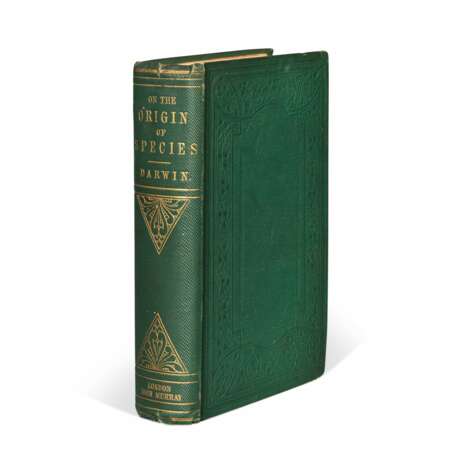Darwin, Charles | An exceptional copy of one of the greatest achievements of scientific discovery
21.07.2022 10:00UTC -05:00
Classic
Prix de départ
250000USD $ 250 000
| Auctioneer | Sotheby´s |
|---|---|
| Lieu de l'événement | Etats-Unis, New York |
Archive
La vente aux enchères est terminée. Vous ne pouvez plus enchérir.

ID 796075
Lot 1010 | Darwin, Charles | An exceptional copy of one of the greatest achievements of scientific discovery
Valeur estimée
$ 250 000 – 300 000
On the Origin of Species by Means of Natural Selection, or the Preservation of Favoured Races in the Struggle for Life. London: John Murray, 1859
In 12s (199 x 126 mm, uncut). Folding lithographed diagram by W. West, half-title verso with quotations by Whewell and Bacon only, 32-page publisher's catalogue dated June, 1859 bound at end (Freeman's form 3; no priority); light vertical creases to half-title and title-page, marginal spot affecting pp. 409-420, tiny chip at foot of p. 205, spots and small closed tear affecting foot of last three leaves. Publisher's blind-paneled green, grained cloth, spine gilt (Freeman's variant a; no priority), brown coated endpapers; short closed tear to head and foot of spine, extremely light rubbing to extremities, lower corners just barely exposed, hinges cracked as usual, last four signatures just slightly separated from the text block. Housed in a green cloth slipcase with folding chemise.
First edition of "the most influential scientific work of the nineteenth century" and "the most important biological work ever written" (Horblit, Freeman). Darwin had assimilated the research and observations from his five years as naturalist aboard the survey ship H.M.S. Beagle into the essential formulation of his theory of natural selection more than two decades before Origin of Species appeared, but he may not have published his revolutionary theory during his lifetime had not Alfred R. Wallace independently come to a nearly identical conclusion about the transmutation of species. After the Linnean Society read and published jointly Darwin and Wallace's preliminary expositions of the theory of evolution, Darwin rushed to prepare for publication an epitome of the "big species book" that he had been working on since 1856. (Darwin’s first suggestion for a title, An Abstract of an Essay on the Origin of Species and Varieties, was rejected by his publisher as too tentative).
Originally conceived as a work that might be printed on four or five sheets of paper, On the Origin of Species evolved during the eight months of its writing into a volume of nearly 500 pages. The final scope of Origin of Species prompted Darwin to abandon plans for his "big book," although he salvaged much of the first part of the manuscript for The Variation of Animals and Plants under Domestication, published in 1868.
Bern Dibner’s Heralds of Science describes On the Origin of Species as "the most important single work in science." The entire text is essentially an introduction to, and amplification of, the iconoclastic thesis that Darwin abstracts at the beginning of chapter 4: "many more individuals are born than can possibly survive … [I]ndividuals having any advantage, however slight, over others, would have the best chance of surviving and procreating their kind … [A]ny variation in the least degree injurious would be rigidly destroyed. This preservation of favourable variations and the rejection of injurious variations, I call Natural Selection." On the Origin of Species caused an immediate sensation. Of the first edition of 1,250 copies, fifty-eight were distributed by Murray for review, promotion, and presentation, and Darwin reported that the balance was sold out on the first day of publication.
An exceptional, entirely unsophisticated copy, rarely seen in this condition.
REFERENCE:
Dibner 199; Freeman 373; Grolier, Science 23b; Grolier, Medicine 70b; Norman 593; Printing and the Mind of Man 344b
PROVENANCE:
Charles Keene (bookplate to pastedown, "E Libris Caroli Keene")
| Artiste: | Charles Robert Darwin (1809 - 1882) |
|---|---|
| Lieu d'origine: | Londres |
| Catégorie maison de vente aux enchères: | Livres |
| Artiste: | Charles Robert Darwin (1809 - 1882) |
|---|---|
| Lieu d'origine: | Londres |
| Catégorie maison de vente aux enchères: | Livres |
| Adresse de l'enchère |
Sotheby´s 1334 York Avenue 10021 New York Etats-Unis | ||||||||||||||
|---|---|---|---|---|---|---|---|---|---|---|---|---|---|---|---|
| Aperçu |
| ||||||||||||||
| Téléphone | +1 212 606 7000 | ||||||||||||||
| Conditions d'utilisation | Conditions d'utilisation | ||||||||||||||
| Heures d'ouverture | Heures d'ouverture
|





